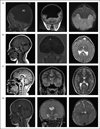Holoprosencephaly: recommendations for diagnosis and management
- PMID: 20859208
- PMCID: PMC4131980
- DOI: 10.1097/MOP.0b013e32833f56d5
Holoprosencephaly: recommendations for diagnosis and management
Abstract
Purpose of review: This review presents recent advances in our understanding and clinical management of holoprosencephaly (HPE). HPE is the most common developmental disorder of the human forebrain and involves incomplete or failed separation of the cerebral hemispheres. The epidemiology, clinical features, causes, diagnostic approach, management, and outcomes of HPE are discussed.
Recent findings: Chromosomal abnormalities account for the most commonly identified cause of HPE. However, there are often unidentifiable causes in patients with nonsyndromic, nonchromosomal forms of HPE. The prevalence of HPE may be underestimated given that patients with mild forms often are not diagnosed until they present with severely affected children. Pregestational maternal diabetes mellitus is the most recognized risk factor for HPE, as supported by recent large-scale epidemiological studies. Genetic studies using microarray-based comparative genomic hybridization technology have resulted in better characterization of important HPE loci.
Summary: HPE encompasses a wide spectrum of forebrain and midline defects, with an accompanying wide spectrum of clinical manifestations. A coordinated, multidisciplinary care team is required for clinical management of this complex disorder. Further research will enable us to better understand the pathogenesis and causes of HPE, and thus to improve the genetic counseling of patients and their families.
Figures



References
-
- Shiota K, Yamada S. Early pathogenesis of holoprosencephaly. Am J Med Genet C Semin Med Genet. 2010;154C:22–28. - PubMed
-
- Orioli IM, Castilla EE. Epidemiology of holoprosencephaly: prevalence and risk factors. Am J Med Genet C Semin Med Genet. 2010;154C:13–21. - PubMed
-
-
Levey EB, Stashinko E, Clegg NJ, Delgado MR. Management of children with holoprosencephaly. Am J Med Genet C Semin Med Genet. 2010;154C:183–190. The authors of this article are clinicians and researchers in the Carter Centers for Brain Research in Holoprosencephaly and Related Malformations. This article provides a very thorough and valuable resource for clinicians who care for children with HPE as it reviews the clinical management and outcomes of children with HPE.
-
-
-
Solomon BD, Pineda-Alvarez DE, Mercier S, et al. Holoprosencephaly flashcards: a summary for the clinician. Am J Med Genet C Semin Med Genet. 2010;154C:3–7. This article provides a summary for clinicians of key information about HPE, in the format of ‘flashcards’. The flashcards illustrate the prevalence, causes, and types of HPE, as well as the craniofacial and neurological findings, physical examination features, the clinical approach, and resources.
-
-
-
Hahn JS, Barnes PD. Neuroimaging advances in holoprosencephaly: refining the spectrum of the midline malformation. Am J Med Genet C Semin Med Genet. 2010;154C:120–132. This article is a valuable resource for understanding the spectrum of HPE specifically as it relates to neuroimaging. The article thoroughly describes the cerebral structure of each type of HPE, with accompanying neuroimages and labels to highlight key features.
-
Publication types
MeSH terms
Grants and funding
LinkOut - more resources
Full Text Sources
Research Materials

